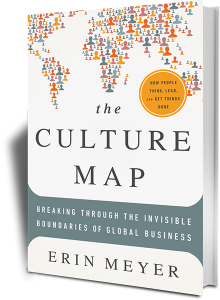One of the realities of parish and community life today is that we nearly always have a meeting of multiple cultures. My own parish is home to first-generation European, Asian, Latin-American, Middle Eastern, and African immigrants, born-and-raised Americans from several different American sub-cultures, and priests born and educated on three different continents. And we aren’t a parish known for “diversity,” we’re just a typical suburban-American parish.
With that in mind, I’d like to recommend an excellent resource for anyone working across more than one culture: The Culture Map by Erin Meyer. My background is in business and in international studies, and over the years I’ve looked in on a number of “diversity” type presentations. Usually they boil down to a few funny stories about what your brandname means in Chinese and an admonishment that we all need to get along and celebrate our uniqueness, pass the baklava and let’s sing a Polynesian folk song. This book is completely different.
Meyer is a professor at INSEAD specializing in the cultural dimension of international business, and she is a consultant for multinational firms trying to solve cross-cultural managerial problems. In The Culture Map, she uses objective assessments of eight aspects of day-to-day business (think: parish or diocesan) interaction to explain how different cultures handle common problems.
For example, in “scheduling,” there are cultures where time is managed to the minute, and anything that doesn’t run like clockwork is considered a failure; there are likewise cultures where a “schedule” is considered at best a vague, moving target. In between those extremes lies a varied spectrum of approaches to time: How late an arrival is rude, and how much is acceptable? Is it okay if the meeting runs longer than scheduled?
Other aspects of cultural variation that are common sources of frustration in parish life include communication and problem-solving. Do you tend to lay everything out explicitly, in excruciating detail, or are listeners expected to read between the lines, or draw on subtle references to shared experiences? Are problems confronted head-on, directly, with a maximum of clarity, or do we approach critical situations with gentleness, patience, and a soft, light touch?
Leadership style and decision making are areas where parishes can run into intense problems if the pastor is from a culture that has a different style than the bulk of parishioners are accustomed to expecting. Should the pastor be a firm leader, willing to make the hard decisions, respected for his authority and competence? Or is the pastor just one more member of the parish, a facilitator whose job is to listen and dialogue, and come to decisions only after a long series of conversations with all who are involved? When decisions are made, are they once-and-for-all, or are they just-for-now? Are meetings called for the purpose of making decisions? Are they a time for discussion and debate? Or is consensus built during an informal preparatory process, and meetings serve to finalize and formalize what was worked out behind the scenes?
Various world cultures aren’t lumped together, but are analyzed individually. There are commonalities, for example, between Japanese and Chinese cultures, but that doesn’t mean that the two are identical. Likewise, two cultures might have a similar approach to leadership, but a completely different approach to scheduling. Every culture’s tendencies falls on a spectrum, and thus it’s important to recognize that even if, say, you and your neighbor both come from consensus-building cultures, one of you might still be a bit more intense about it than the other. That difference can still create conflict if you aren’t aware of it. The Culture Map acknowledges that individual personalities and talents also have a bearing on our approach to working with others.
For each of the eight attributes that the book discusses, Meyer proposes practical, tested ways of overcoming misunderstandings and developing a mutually-acceptable way of working together. In some areas, such as leadership style or conflict-resolution, that might involve a give-and-take process, which requires everyone to recognize style differences and adapt their expectations. In other areas, such as communication patterns, Meyer draws on her research to explain which modes of communication have proven the most successful in cross-cultural collaboration.
The Culture Map wasn’t written for churches. It was written for business leaders trying to keep their organization afloat while working internationally. But the Church is the ultimate in cross-cultural, international communities. I highly recommend this book for anyone who wants to help spread the Good News to the ends of the earth.
Copyright 2014, Jennifer Fitz
2 responses to “Culture and Evangelization: Working with the People You’ve Got”
Leave a Reply
You must be logged in to post a comment.





[…] All that was one train of thought. For a nice book recommendation (not mine) concerning culture and thus indirectly the question of evangelization, see my review of The Culture Map over at New Evanglizers. […]
[…] the other week.] If you live someplace with people in it, there’s a book you might find helpful. At New Evangelizers I review The Culture Map by Erin Meyer. It isn’t what you think it […]